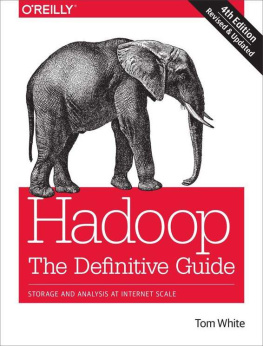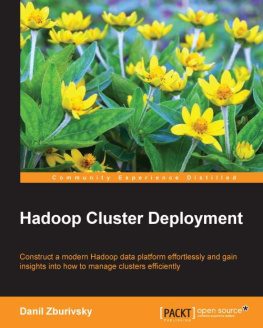We have a web page for this book, where we list errata, examples, and any additional information. You can access this page at http://oreil.ly/hadoop_operations.
To comment or ask technical questions about this book, send email to .
For more information about our books, courses, conferences, and news, see our website at http://www.oreilly.com.
Acknowledgments
I want to thank Aida Escriva-Sammer, my wife, best friend, and favorite sysadmin, for putting up with me while I wrote this.
None of this was possible without the support and hard work of the larger Apache Hadoop community and ecosystem projects. I want to encourage all readers to get involved in the community and open source in general.
Matt Massie gave me the opportunity to do this, along with OReilly, and then cheered me on the whole way. Both Matt and Tom White coached me through the proposal process. Mike Olson, Omer Trajman, Amr Awadallah, Peter Cooper-Ellis, Angus Klein, and the rest of the Cloudera management team made sure I had the time, resources, and encouragement to get this done. Aparna Ramani, Rob Weltman, Jolly Chen, and Helen Friedland were instrumental throughout this process and forgiving of my constant interruptions of their teams. Special thanks to Christophe Bisciglia for giving me an opportunity at Cloudera and for the advice along the way.
Many people provided valuable feedback and input throughout the entire process, but especially Aida Escriva-Sammer, Tom White, Alejandro Abdelnur, Amina Abdulla, Patrick Angeles, Paul Battaglia, Will Chase, Yanpei Chen, Eli Collins, Joe Crobak, Doug Cutting, Joey Echeverria, Sameer Farooqui, Andrew Ferguson, Brad Hedlund, Linden Hillenbrand, Patrick Hunt, Matt Jacobs, Amandeep Khurana, Aaron Kimball, Hal Lee, Justin Lintz, Todd Lipcon, Cameron Martin, Chad Metcalf, Meg McRoberts, Aaron T. Myers, Kay Ousterhout, Greg Rahn, Henry Robinson, Mark Roddy, Jonathan Seidman, Ed Sexton, Loren Siebert, Sunil Sitaula, Ben Spivey, Dan Spiewak, Omer Trajman, Kathleen Ting, Erik-Jan van Baaren, Vinithra Varadharajan, Patrick Wendell, Tom Wheeler, Ian Wrigley, Nezih Yigitbasi, and Philip Zeyliger. To those whom I may have omitted from this list, please forgive me.
The folks at OReilly have been amazing, especially Courtney Nash, Mike Loukides, Maria Stallone, Arlette Labat, and Meghan Blanchette.
Jaime Caban, Victor Nee, Travis Melo, Andrew Bayer, Liz Pennell, and Michael Demetria provided additional administrative, technical, and contract support.
Finally, a special thank you to Kathy Sammer for her unwavering support, and for teaching me to do exactly what others say you cannot.
Portions of this book have been reproduced or derived from software and documentation available under the Apache Software License, version 2.
Chapter 1. Introduction
Over the past few years, there has been a fundamental shift in data storage, management, and processing. Companies are storing more data from more sources in more formats than ever before. This isnt just about being a data packrat but rather building products, features, and intelligence predicated on knowing more about the world (where the world can be users, searches, machine logs, or whatever is relevant to an organization). Organizations are finding new ways to use data that was previously believed to be of little value, or far too expensive to retain, to better serve their constituents. Sourcing and storing data is one half of the equation. Processing that data to produce information is fundamental to the daily operations of every modern business.
Data storage and processing isnt a new problem, though. Fraud detection in commerce and finance, anomaly detection in operational systems, demographic analysis in advertising, and many other applications have had to deal with these issues for decades. What has happened is that the volume, velocity, and variety of this data has changed, and in some cases, rather dramatically. This makes sense, as many algorithms benefit from access to more data. Take, for instance, the problem of recommending products to a visitor of an ecommerce website. You could simply show each visitor a rotating list of products they could buy, hoping that one would appeal to them. Its not exactly an informed decision, but its a start. The question is what do you need to improve the chance of showing the right person the right product? Maybe it makes sense to show them what you think they like, based on what theyve previously looked at. For some products, its useful to know what they already own. Customers who already bought a specific brand of laptop computer from you may be interested in compatible accessories and upgrades.[] One of the most common techniques is to cluster users by similar behavior (such as purchase patterns) and recommend products purchased by similar users. No matter the solution, all of the algorithms behind these options require data and generally improve in quality with more of it. Knowing more about a problem space generally leads to better decisions (or algorithm efficacy), which in turn leads to happier users, more money, reduced fraud, healthier people, safer conditions, or whatever the desired result might be.














